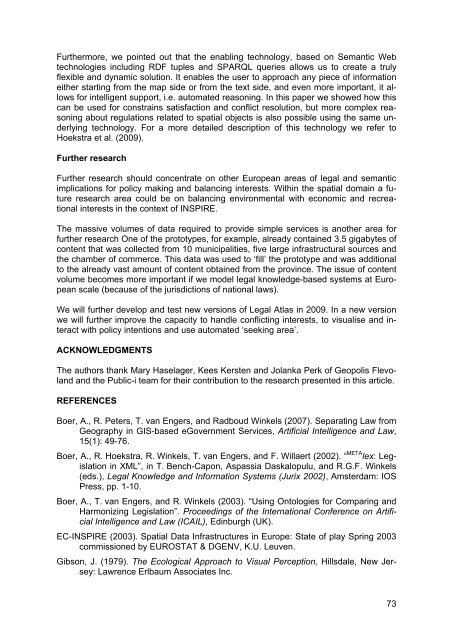SDI Convergence - Nederlandse Commissie voor Geodesie - KNAW
SDI Convergence - Nederlandse Commissie voor Geodesie - KNAW
SDI Convergence - Nederlandse Commissie voor Geodesie - KNAW
You also want an ePaper? Increase the reach of your titles
YUMPU automatically turns print PDFs into web optimized ePapers that Google loves.
Furthermore, we pointed out that the enabling technology, based on Semantic Web<br />
technologies including RDF tuples and SPARQL queries allows us to create a truly<br />
flexible and dynamic solution. It enables the user to approach any piece of information<br />
either starting from the map side or from the text side, and even more important, it allows<br />
for intelligent support, i.e. automated reasoning. In this paper we showed how this<br />
can be used for constrains satisfaction and conflict resolution, but more complex reasoning<br />
about regulations related to spatial objects is also possible using the same underlying<br />
technology. For a more detailed description of this technology we refer to<br />
Hoekstra et al. (2009).<br />
Further research<br />
Further research should concentrate on other European areas of legal and semantic<br />
implications for policy making and balancing interests. Within the spatial domain a future<br />
research area could be on balancing environmental with economic and recreational<br />
interests in the context of INSPIRE.<br />
The massive volumes of data required to provide simple services is another area for<br />
further research One of the prototypes, for example, already contained 3.5 gigabytes of<br />
content that was collected from 10 municipalities, five large infrastructural sources and<br />
the chamber of commerce. This data was used to ‘fill’ the prototype and was additional<br />
to the already vast amount of content obtained from the province. The issue of content<br />
volume becomes more important if we model legal knowledge-based systems at European<br />
scale (because of the jurisdictions of national laws).<br />
We will further develop and test new versions of Legal Atlas in 2009. In a new version<br />
we will further improve the capacity to handle conflicting interests, to visualise and interact<br />
with policy intentions and use automated ‘seeking area’.<br />
ACKNOWLEDGMENTS<br />
The authors thank Mary Haselager, Kees Kersten and Jolanka Perk of Geopolis Flevoland<br />
and the Public-i team for their contribution to the research presented in this article.<br />
REFERENCES<br />
Boer, A., R. Peters, T. van Engers, and Radboud Winkels (2007). Separating Law from<br />
Geography in GIS-based eGovernment Services, Artificial Intelligence and Law,<br />
15(1): 49-76.<br />
Boer, A., R. Hoekstra, R. Winkels, T. van Engers, and F. Willaert (2002). “ META lex: Legislation<br />
in XML”, in T. Bench-Capon, Aspassia Daskalopulu, and R.G.F. Winkels<br />
(eds.), Legal Knowledge and Information Systems (Jurix 2002), Amsterdam: IOS<br />
Press, pp. 1-10.<br />
Boer, A., T. van Engers, and R. Winkels (2003). “Using Ontologies for Comparing and<br />
Harmonizing Legislation”. Proceedings of the International Conference on Artificial<br />
Intelligence and Law (ICAIL), Edinburgh (UK).<br />
EC-INSPIRE (2003). Spatial Data Infrastructures in Europe: State of play Spring 2003<br />
commissioned by EUROSTAT & DGENV, K.U. Leuven.<br />
Gibson, J. (1979). The Ecological Approach to Visual Perception, Hillsdale, New Jersey:<br />
Lawrence Erlbaum Associates Inc.<br />
73

















